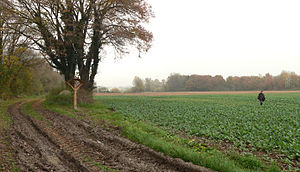Posteburg
| Posteburg | ||
|---|---|---|
|
Location of the Posteburg in a field, on the left an information board set up for the castle |
||
| Creation time : | probably around 1384 | |
| Castle type : | Niederungsburg | |
| Conservation status: | Burgstall | |
| Standing position : | Lower nobility | |
| Construction: | Truss | |
| Place: | Hülsede -Schmarrie | |
| Geographical location | 52 ° 14 '33.3 " N , 9 ° 23' 29.4" E | |
|
|
||
The Poste castle is the Burgstall an earlier castle in sleeve of the district Schmarrie in Lower Saxony . The remains of the castle lie in a lowland area within the Deister-Süntel valley about 1.2 km east of Schmarrie, directly on the brook of the Rodenberger Aue . Archaeological investigations indicate a small moated castle surrounded by a moat , as the seat of a noble family . The, and probably only, building located on a corner of the castle complex had a defensive character. An outer bailey, also protected by a moat, belonged to the castle .
description
In 1972 a farmer noticed superficial traces such as remains of masonry and fire debris in the ground when turning grassland into arable land. He drew the traces in a sketch, and later communicated this to institutions of monument preservation . Because of the ongoing threat to the site from agriculture , there were intensive prospecting measures such as phosphate mapping, geomagnetics , geoelectrics , site inspections and aerial photo interpretation between 1988 and 1993 by the state preservation of monuments . This led to a targeted excavation in 1992 .
The 1.6 meter wide stone foundations of an approximately 9 × 19 meter building, which was considered to be the main building, were excavated. While the outer walls, with their 1.5 meter deep foundations, had a defensive character, the walls on the inside of the building were narrower, which suggests a lighter half-timbered construction . Remnants of roof tiles indicated a solid roof covering. Stove tiles indicated that the system was being heated. Recesses in the stone wall and post pits indicated a fortified fence made of wooden planks. Due to the fragments of ceramic parts such as jugs and jugs, the period of use of the facility is assumed to be at the end of the 14th and beginning of the 15th century. Due to the large number of drinking vessels found, it is assumed that when leaving the castle, the farewell was celebrated. Numerous animal bones were found in the ground, and it was found that cattle and pork were the main suppliers of meat for the castle residents. Iron parts found were a wheel spur and a door lock as well as smaller components such as nails and pins. In addition, an iron tip of a were crossbow arrow and parts of a bronze Kumpfes found.
history
The complex probably only existed for a few decades as a border castle of a small noble lordship on the eastern edge of the Schaumburg territory. It could be identical to a Nyghenborch of the Lords of Post mentioned in a document in 1384 . According to one theory, the Posteburg lost its importance at the beginning of the 15th century and was therefore torn down around 1411. During this time the territorial disputes between the Counts of Schaumburg and the Dukes of Braunschweig had calmed down. The field name Posteburg at the castle site has been documented since 1659.
literature
- Hans-Wilhelm Heine : The Posteburg. A late medieval moated castle between Deister and Süntel In: Mamoun Fansa , Frank Both, Henning Haßmann (editor): Archeology | Land | Lower Saxony. 400,000 years of history. State Museum for Nature and Man, Oldenburg 2004. Pages 568–571.
- Hans-Wilhelm Heine: Schaumburger Land - Burgenland , in the series Guide to the Prehistory and Early History of Lower Saxony (29), Oldenburg, 2010, published by the Lower Saxony State Office for Monument Preservation and the Archaeological Commission for Lower Saxony , ISBN 978-3-89995-673- 3

